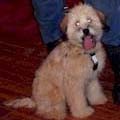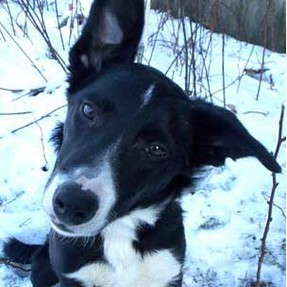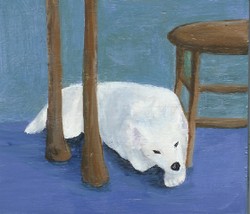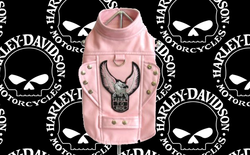Your new puppy needs to learn how to live with a human family. Here's some training tips to get your puppy started off right.

Six Things a Puppy Should Know
by Ragtimelil
Here are six things a puppy should know by the time they are six months old.
The Six Things

- Not to soil the house
- To come when called
- To walk on a leash without pulling
- Not to jump on people
- Not to chew anything forbidden
- Not to bite
Training Basics:
Dogs do things that are natural for dogs, but may not be so good for social living with humans. They must be taught to have manners and the correct way to behave just like children do. The difference with training a dog, however, is that you can’t discuss it with them or explain it to them. You have about ½ of a second to react so that the dog will make the connection between his behavior and your reaction to it. That’s why some people have trouble when it comes to housebreaking a dog. Their response may come hours later. The dog doesn’t connect the act of going in the house with the punishment.
Housebreaking
Soiling the house is something almost every puppy will do at least once. It’s natural for them to keep their den clean, but the house is too big for a dog to understand that the whole house is their den. The trick is to prevent it by keeping puppies crated or confined and taking them out on schedule. Once they understand to go outside, you can start to give them more freedom, a little at a time.
Don’t make the mistake of thinking the dog will “outgrow” soiling the house. He has to be shown where it is acceptable to go. If he starts to squat in the house, make a loud noise, a yell, stamp a foot, clap hands, try to startle the pup into stopping what he is doing. Take him outside immediately. When he goes outside, praise him and let him have some fun time in the yard or back in the house. Do not let him see you clean up his mess.
Coming When Called
Coming when called is so important, I wrote a whole article on it. Even if the dog is never off the leash, he or she still should know to come when called. This can be a life-saving response if the dog should ever get loose.
There are some rules to teaching a dog to come when called. Never call him for punishment, or what he would perceive as punishment whether getting a bath or going into his crate. Always praise the dog for coming.
For more detailed instructions on teaching this, visit my article on The One Thing Every Dog Should Know.
Walking on a Leash
Dogs that pull on the leash are not only annoying, but can actually injure their handlers. I taught all of my students to never wrap the leash around their hands, but to fold it up with their thumb through the loop. The dog would be safe, and, in case of emergency, the handler could release the folded leash, giving them a few seconds to get their balance or, if necessary, release the dog altogether.
I saw a mother hand the leash of a big Lab to her preteen child who was wearing shorts. The child wrapped the leash around his hand. The dog pulled the child over and dragged him across the asphalt parking lot. Ouch.
Another adult student of mine came to class one evening with a black eye and bruises on her face. She told us that it was caused by their standard poodle pulling her down in her excitement at going for a walk. She had the leash wrapped around her hand. She told the class that from then on, she would hold the leash the way I had taught them.
There are many methods to teach a dog to walk calmly and not pull, from the use of training collars, head halters, elaborate no-pull halters, to luring the dog with treats, changing direction every time the dog gets too far ahead or pulls. Here's one of many videos on YouTube.
Train Your Dog Not to Pull on the Leash
Jumping Up on People
.You may not mind if your dog shows his affection for you by jumping up, but what if he has muddy paws? Or Aunt Mildred is coming to visit and she has trouble standing up on her feet? Or your sister is bringing over her baby who is just learning to walk?
It’s not fair to the dog and just confuses him if one time it’s ok for him to jump up and the next time he’s punished for it. It’s best to make a rule and stick to it. Here’s a great video on teaching the dog not to jump that is excellent for small dogs as well as large ones.
Training Your Dog Not to Jump
Chewing
All puppies explore with their mouths. It’s a natural part of growing up. In addition, puppies need to chew when they are teething. There are two teething stages, one at about 4 months when the adult teeth are coming in, and one at about a year when the teeth really settle into their jaws. They simply must chew. The trick is to give them something that they can chew and train them not to chew on furniture, shoes or other objects.
Puppies should not have more that three or so toys out at any given time. Otherwise, they are too likely to become confused about what toy is theirs. If they are chewing something they shouldn’t, reprimand them gently and then give them a toy they can chew. Before long they will get the idea and stick to their own toys. If they are to be left alone for a period of time, it’s best to confine them to a small area or a crate and leave a chew toy or two with them.
Stop Chewing
Biting
Along with chewing problems comes biting. It starts as puppy play but can become serious if allowed to continue. Gradually teach the puppy to play with toys instead of your hands or feet. Here are some things to do.
If the puppy nips hard, yell, “ow” and turn away and stop playing.
Give the pup a toy to play with.
Stop the Biting
Puppies
A six-month-old puppy is still very young. He may not be perfect in all his training, but he should know these six things and understand the correct way to live with his human family. I recommend using clicker training to get your puppy started off right.
Housebreaking
 | StarMark Clicker Dog Training System Ergonomic training clicker based on scientific principles of operant and classical conditioning. Only $5.0 |
 | PoochieBells Solid Classic Black Dog Potty Training Doorbell PoochieBells Dog Potty Training Doorbell, easily and quickly potty train any age dog/breed to ring their PoochieBells when its potty time. Each PoochieBells comes with easy to f... |
 | Before and After Getting Your Puppy: The Positive Approach to Raising a Happy, Healthy, and Well-... Combining two popular titles in one value-priced edition, Before and After Getting Your Puppy is a simple, practical guide for anyone bringing a new puppy into the home. In clea... Only $4.27 |
 | Nylabone Dura Chew Wishbone Chew Toy, Original Flavor, Wolf Designed for powerful chewers. Bristles raised during chewing help clean teeth and control plaque & tartar build-up. Only $9.69 |
 | Premier Gentle Leader Head Dog Collar, Black, Medium More than two million dog owners have found the secret to stress-free walks. Immediately eliminates pulling on the leash. With the Gentle Leader, when you steer the dog's nose, ... |
 | Canny Collar for Dogs, Black, Size 4 Walking with your dog on a leash is a great way for both of you to get exercise. But if you have a dog that constantly pulls, it is not an enjoyable time for either of you. Some... Only $24.95 |
Articles You Might Like
by Ragtimelil
You might also like
Pink Biking Jacket for a Lapdog Hell's AngelThey are the wolves of the street! But they've been saddled with a reputation...
Pet Store Puppies and Puppy MillsBuy a pet store puppy and you support puppy mills, commercial breeding operat...



 How I Found My Free Family History Programon 09/05/2013
How I Found My Free Family History Programon 09/05/2013
 Finding a Graveon 09/01/2013
Finding a Graveon 09/01/2013
 Do Border Collies Make Good Pets?on 08/11/2013
Do Border Collies Make Good Pets?on 08/11/2013
 Hubert Patey - an Indentured Servanton 08/02/2013
Hubert Patey - an Indentured Servanton 08/02/2013



Tell Me About Your Smart Puppy!
Thanks Sheliamarie. Yes, taking in an older dog certainly can have some advantages. Good for you!
Such helpful advice, Ragtimelil! I've been fortunate in not having to train a puppy as all our dogs came to us after living with someone else for a few years. There are bad and good things about that, but they were all house-trained at least.
Thank you for the kind words. I do like to see new puppies and new owners get off on the right foot. The first year is the most work, but it pays off in the end.
Very nice guide for new puppies. Dogs are such wonderful additions to a family and a new puppy well, I imagine many Aw's and smiles. Nothing like a new puppy, thanks for helping us to understand best how to train them.
That is a big one alright! Keep at it. She'll learn.
We have a new puppy that we are working with now on not chewing up everything in the house. Boy this is a task! She loves to chew on everything.